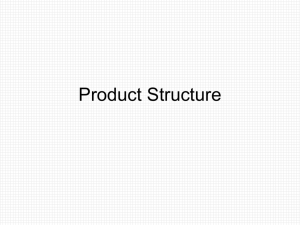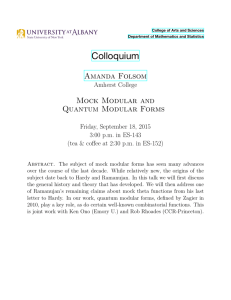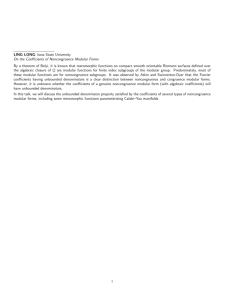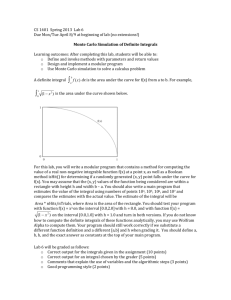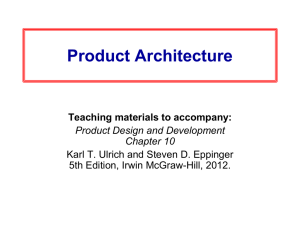ProdArch - Rose
advertisement
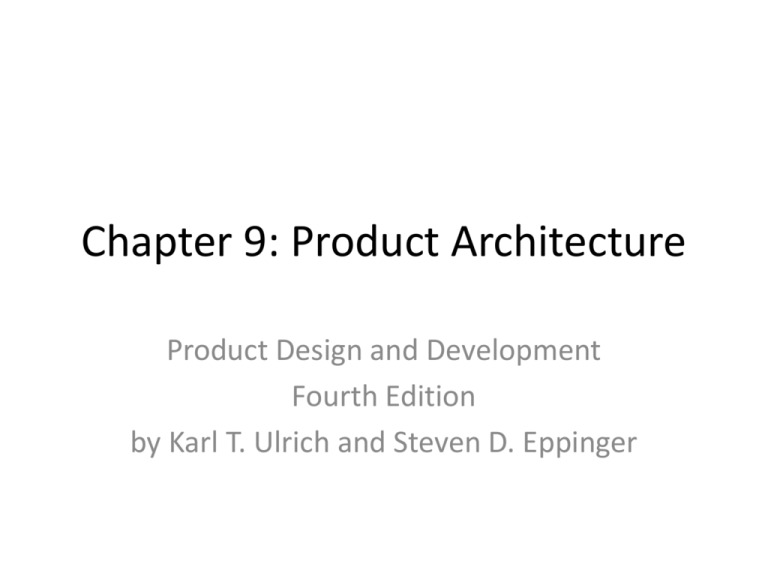
Chapter 9: Product Architecture Product Design and Development Fourth Edition by Karl T. Ulrich and Steven D. Eppinger Product Design and Development Karl T. Ulrich and Steven D. Eppinger 2nd edition, Irwin McGraw-Hill, 2000. Chapter Table of Contents 1. 2. 3. 4. 5. 6. 7. 8. 9. 10. 11. 12. 13. 14. Introduction Development Processes and Organizations Product Planning Identifying Customer Needs Product Specifications Concept Generation Concept Selection Concept Testing Product Architecture Industrial Design Design for Manufacturing Prototyping Product Development Economics Managing Projects Product Development Process Planning Platform decision Concept Development System-Level Design Detail Design Testing and Refinement Production Ramp-Up Concept Decomposition decision decision Product architecture is determined early in the development process. Product Architecture: Definition The arrangement of functional elements into physical chunks which become the building blocks for the product or family of products. module module module module Product module module module module Aspects of Product Architecture • • Modularity Point of product differentiation Importance of Product Architecture • • • • Decided early and drives design Impacts manufacturing cost Impacts product evolution Impacts organization structure of design teams Modular Design Displays the Following Properties: • Each physical chunk implements one or a few functional elements in their entirety • The interactions between chunks are well defined (i.e. the interfaces are well defined) Integral Product Architectures • Functional elements are implemented by multiple chunks, or a chunk may implement many functions. • Interactions between chunks are poorly defined. • Integral architecture generally increases performance and reduces costs for any specific product model. Modular or Integral? Examples • Video Games – Modular: gaming systems (e.g. GameCube) – Integrated: stand-alone arcade games • Power Supplies – Modular: power bricks – Integrated: on-board power converter Trailer Example: Modular Architecture box protect cargo from weather hitch connect to vehicle fairing minimize air drag bed support cargo loads springs suspend trailer structure wheels transfer loads to road Trailer Example: Integral Architecture upper half protect cargo from weather lower half connect to vehicle nose piece minimize air drag cargo hanging straps support cargo loads spring slot covers suspend trailer structure wheels transfer loads to road Integral vs. Modular Integral • Higher system performance • Tightly coupled design teams • Hard to change • • • • • Modular Reduced performance Decoupled design teams Requires clear definition of interfaces Increased flexibility Accommodates made-to-order products What is this? Nail Clippers? Modular or Integral Architecture? Apple iBook Motorola StarTAC Cellular Phone Ford Explorer Rollerblade In-Line Skates Types of Modularity • Slot-Modular Architecture – unique interfaces for attachment to a base element (e.g. pacemaker leads) • Bus-Modular Architecture – common interfaces for attachment to a base element (e.g. USB connectors on a computer) • Sectional-Modular Architecture – Common interfaces between elements without a base element (e.g. legos & piping) Bus? Slot? Sectional? Choosing the Product Architecture Architecture decisions relate to product planning and concept development decisions: • Product Change (copier toner, camera lenses) • Product Variety (computers, automobiles) • Standardization (motors, bearings, fasteners) • Performance (racing bikes, fighter planes) • Manufacturing Cost (disk drives, razors) • Project Management (team capacity, skills) • System Engineering (decomposition, integration) The concepts of integral and modular apply at several levels: • system • sub-system • component Product Architecture = Decomposition + Interactions • Interactions within chunks • Interactions across chunks Product Architecture Example: Hewlett-Packard DeskJet Printer Establishing the Architecture To establish a modular architecture, create a schematic of the product, and cluster the elements of the schematic to achieve the types of product variety desired. DeskJet Printer Schematic Enclose Printer Print Cartridge Provide Structural Support Functional or Physical Elements Position Cartridge In X-Axis Store Output Position Paper In Y-Axis Store Blank Paper “Pick” Paper Flow of forces or energy Flow of material Flow of signals or data Accept User Inputs Display Status Control Printer Supply DC Power Communicate with Host Connect to Host Command Printer Cluster Elements into Chunks Enclosure Enclose Printer Print Cartridge Provide Structural Support Chassis Functional or Physical Elements Position Cartridge In X-Axis Store Output Position Paper In Y-Axis Store Blank Paper “Pick” Paper Paper Tray Print Mechanism Chunks User Interface Board Accept Display User Status Inputs Control Printer Communicate with Host Connect to Host Logic Board Power Cord and “Brick” Supply DC Power Command Printer Host Driver Software Geometric Layout logic board user interface board print cartridge paper tray print mechanism chassis enclosure print cartridge height roller paper logic board chassis paper tray Incidental Interactions User Interface Board Enclosure Styling Paper Tray Vibration Thermal Distortion Chassis Print Mechanism Thermal Distortion RF Shielding Logic Board RF Interference Power Cord and “Brick” Host Driver Software Additional Advantage to Modular Design: HP products are designed to be recycled. Recycling design features include: • Modular design to allow components to be removed, upgraded or replaced • Eliminating glues and adhesives, for example, by using snap-in features • Marking plastic parts weighing more than 25g according t ISO 11469 international standards, to speed up materials identification during recycling • Reducing the number and types of materials used • Using single plastic polymers • Using molded-in colors and finishes instead of paint, coatings or plating • Relying on modular designs for ease of disassembly of dissimilar recyclable materials http://www.hp.com/hpinfo/globalcitizenship/environment/productdesign/endoflife.html Planning a Modular Product Line: Commonality Table Number of Types Family Student SOHO (small office, home office) Chunks Print cartridge 2 “Manet” Cartridge “Picasso” Cartridge “Picasso” Cartridge Print Mechanism 2 "Aurora" Series Narrow "Aurora" series "Aurora" series Paper tray 2 Front-in Front-out Front-in Front-out Tall Front-in Front-out Logic board 2 “Next gen” board with parallel port “Next gen” board “Next gen” board Enclosure 3 Home style Youth style “Soft office” style Driver software 5 Version A-PC Version A-Mac Version B-PC Version B-Mac Version C Differentiation versus Commonality Trade off product variety and production complexity Fundamental Decisions • • • • • Integral vs. modular architecture? What type of modularity? How to assign functions to chunks? How to assign chunks to teams? Which chunks to outsource? System Team Assignment Based on Product Architecture Crankshaft Flywheel Connecting Rods Pistons Lubrication Engine Block Camshaft/Valve Train Cylinder Heads Intake Manifold Water Pump/Cooling Fuel System Air Cleaner Throttle Body EVAP Cylinder Heads Intake Manifold A.I.R. Exhaust E.G.R. Accessory Drive Ignition E.C.M. Electrical System Engine Assembly F G E D I A C B1 K1 F G E D I A C B1 K1 J P N Q R B2 K2 O L M H S T U V l l l l l F l l l l l l l l l l l l G Team 1 l l l E l l l l l l l l l D l l l l l l l l l l l l l l l l l l I l l Team 2 l l l l l l l A l l l l l l l l l l l l l l l l C l l l l l l l l l B1 l l l l l l l Team 3 l K1 l l l l l l J l l l l l P N Q R B2 K2 O L M H S T U V J l l l l P l l l N l l l Integration Team l l l l l l l l l l l l l l l l l l l l l l l l l l l l l l l l l l l l l l l l l l l l l l l l l l l l l l l l l l l l l l l l l l l l l l l Q l l R l l l l l l l l l l l l l l l l l l l l Team 4 l B2 l l l l l l l l l K2 l l l l l l l O l l l l l l l l L l l l l M l l l H l l l l l S l l l l l l l l l l T l l l l l l l l l l l l l l l l l l l l l l l l l l l l l l l l l l l l l l l l l l l l l l l l l l l l l l l l l U l l V Frequency of PDT Interactions l l Weekly Daily Monthly From “Innovation at the Speed of Information”, S. Eppinger, HBR, January 2001. Practical Concerns • Planning is essential to achieve the desired variety and product change capability. • Coordination is difficult, particularly across teams, companies, or great distances. • Special attention must be paid to handle complex interactions between chunks (system engineering methods). Product Architecture: Conclusions • Architecture choices define the sub-systems and modules of the product platform or family. • Architecture determines: – ease of production variety – feasibility of customer modification – system-level production costs • Key Concepts: – modular vs. integral architecture – clustering into chunks – planning product families Power Bricks are annoying to most consumers. Why are they viewed as a good example of modular design? Point of Product Differentiation The point in the manufacturing process where a product can only be made into a specific stock keeping unit (SKU) Delayed Point of Product Differentiation • The point in the manufacturing process where an item is limited to use for a single specific product is called the “Point of Product Differentiation” • Delaying the point of product differentiation is called “Late Point Product Differentiation” Delayed differentiation or Postponement is a concept in supply chain management where the manufacturing process starts by making a generic or family product that is later differentiated into a specific end-product. This is a widely used method, especially in industries with high demand uncertainty, and can be effectively used to address the final demand even if forecasts cannot be improved. An example would be Benetton and their knitted sweaters that are intially all white, and then dyed into different colored only when the seasons customer color preference/demand is know. It is usually necessary to redesign the products specifically for delayed differentiation, and resequence to modify the order of product manufacturing steps. From Wikipedia back Advantages of Late Point Product Differentiation • Reduced inventories • More easily respond to demand variation Late Point Differentiation Examples • Paint where pigment is added at the store • Benetton sweaters • HP printers Modular Design allows for Late Point Differentiation http://web.mit.edu/course/2/2.996/www/lecture5/sld038.htm http://web.mit.edu/course/2/2.996/www/lecture5/sld038.htm Late Point Differentiation Principles • The differentiating elements of the product must be concentrated in one or a few chunks • The product and production process must be designed so that the differentiating chunk(s) can be added to the product near the end of the supply chain. Platform Planning The process of deciding what should be shared across products and what should be unique across products? For example: – How many driveshafts should you have for a Ford F150? Platform Planning • Attempts to resolve the tension between 1. Differentiating the product for various customers 2. Taking advantage of the economic benefits of using common components • Product architecture will determine what trade-offs are available… if no good options are available, see if the options can be improved by changing the product architecture

